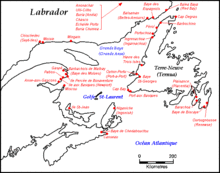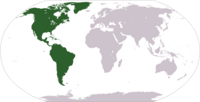Basque colonization of the Americas
| Part of a series on |
| European colonization of the Americas |
|---|
 |
|
|
The settlement of Basques in the Americas was the process of Basque emigration and settlement in the New World. Thus, there is a deep cultural and social Basque heritage in some places in the Americas, the most famous of which being Saint Pierre and Miquelon, Central America, Guatemala and Antioquia, Colombia.
Background
Basques and
The most important nuclei of Basque immigration into the Americas were located on the Labourd coast, including
Colonization of North America
Basque monopoly (1530-1580)
Establishment

The first Basque expedition recorded in Newfoundland took place in 1517, but it was around 1530s that a regional establishment could be identified.[1] Its assumed that Basque fishermen gradually approached the American continent, by pursuing cod in first instance, and progressively derivating to the more profitable whaling.[1] It wasn't the decline of European whales that drove Basque fisherman to Newfoundland; rather, it was the techniques and trade developed in their sardine fishing expeditions in Ireland or whaling on their coasts that enabled the Basques to establish a lucrative monopoly in Labrador.[2] Additionally, Breton cod fishermen frequented Newfoundland before the Basques, the latest expedition being in 1536, and it was from the Bretons that the Basque became aware of the rich population of cetaceans in Newfoundland waters.[2]
Subsequently, the Basque began fishing for cod in the south of Newfoundland, in Plaisance Bay (now Placentia),[1] St. Mary's Bay and Trepassey, as well as in the east in places like St John's and Renews-Cappahayden.[1] Other fishing sites were recorded in the Strait of Belle Isle, between Labrador and Newfoundland, around 1535. A third area, near the Strait of Canso, was also frequented by Basque fisherman in the 1560s.[1]

When
Fishermen continued to fish in late summer, just before the whales migrate.[1] It is from the Buitres site of which the most written evidence remains, including those mentioning the sinking of the Basque ship San Juan in 1563, the disastrous winter of 1576–1577, and a will signed shortly after by a dying Basque, the first document of the genre written in Canada. The documents mainly cover the period from 1548 to 1588, and the last winter the Basques spent there was in 1603.[2]
French - Spanish rivalry
The
English opposition / decline of the whaling industry
During the 1570s, the Basque
Loewen and Delmas argue that it's the opposition of the English to the Spanish monopoly that resulted in this decline. Basque merchants were becoming increasingly threatened in English ports. In 1578, Captain
Whaling expeditions continued to decline; the season of 1578 was preemptively disrupted, and the season of 1579 was cancelled. New hunting expeditions were organized in 1582, but the Admiralty forced the boats to go to the
Displacement to the Gulf of Saint Lawrence (1580-1630)

Despite the destruction of the industry in the Strait of Belle Isle, the Basques settled further west in the Gulf of St. Lawrence. They are among the first Europeans to settle there and occupy strategic sites. Historians have mostly focused on their commercial activities, but fishing continued to flourish modestly too. The Hoyarsabal brothers, from Saint-Jean-de-Luz, set up whalers and merchants in the St. Lawrence estuary as early as 1581. Archaeological remains have been discovered on Île aux Basques and on Côte-Nord in sites identified as Chafaud-aux-Basques and Les Escoumins. Les Escoumins is abandoned between 1607 and 1611, while Chafaud-aux-Basques was still occupied until 1632; however, fishermen only intermittently visited the sites.[1]
Two Basque ships crashed in St. George's Bay, southwestern Newfoundland, in 1591. This is the first mention of a Basque presence in the region.
Two battles are fought between the Basques and the English corsairs to control the hunting of the Magdalen Islands' walruses, with the last in 1597.[1]
The
There was extensive contact between the Basques and the
Associates from the Caen Trading Company and
The Basques set out to hunt in Svalbard in 1612, attracted by the greater number of whales and the shorter distance. However, they experienced a violent clash with the English in 1613. They still tried to hunt in the North Sea over the next years without major success, still believing that hunting in Labrador is no longer good enough.[2]
Height of the cod fisheries (1630-1713)
Due to the ensuing
Cod fishermen are divided into two groups. One was those of Labourd operating on the southern shore of the Gulf, between Gaspé and
The second group, coming from Guipuzcoa and Biscay, settled on the west shore of Newfoundland and in the Lower North Shore.[2] Their presence is better known, thanks to the work of the geographers of the time on behalf of the French government, as well as documents from the consultations of the Spanish Admiralty in 1697. Plaisance became the capital of French Newfoundland in 1662 and continued to welcome fishermen from these two Basque provinces.[1]
Decline (1713-1760)
These Basque hunters and fishermen continue their activities in safety until the end of the 18th century, but the industry is no longer considered important to the Spanish side. The French Basques, continued to make hunting trips in southern Labrador during the 18th century, often from the Fortress of Louisbourg.[2] The lordships are even granted to southern Labrador to Quebec merchants.[2]
From 1689, the
The Treaty of Paris (1763) which abandoned New France to the United Kingdom (except for Saint Pierre and Miquelon) permanently deprived the Basque ports of their influence in North America. Those of Basque heritage either immigrated to other places or settled quietly.
Colonization of South America
The Basque colonization of South America was driven mainly due to the decline of the Spanish Empire. Some Basques took advantage of the post-independence movements in Latin America to emigrate to South America for financial prospects. Many either remained in South America or returned to Basque country after earning fortunes.
Basque emigration to Argentina and Uruguay
The push of external and internal causes in Basque country, such as the
The first stage of immigration to Argentina (1835 - 1853) occurred among Basque shepherds in the northern Basque country. It was followed by a post-constitutional stage (1853 - 1877) where many emigrants settled in the Pampas region. Later, between 1877 and 1914, following the Argentine adaption of the immigration law, another wave of Basque immigrants followed.
Legacy
Algonquian-Basque pidgin
Algonquian-Basque pidgin was a pidgin spoken by Basque whalers and peoples of Algonquian languages such as Mi'kmaq, the Innu and Inuit of Labrador in the area of the Strait of Belle Isle and Northern St. Lawrence Gulf to the Atlantic Ocean. Elements of Basque are preserved in the Mi'kmaq language, such as atlai ("shirt", deriving from the Basque atorra) and elege ("king", deriving from the Basque errege).[6]
Religion and Symbols

When Jacques Cartier meet the Mi'kmaq during his first trip in 1534, some wore a cross around their neck, signifying an older contact with Christianity. Additionally, he noted the Mi'kmaq decorated their canoes and baskets with a symbol that happens to be the lauburu, or Basque cross.[7]
The unofficial flag of Saint Pierre and Miquelon, along with its coat of arms, incorporates the Basque flag.[8]
Toponymy
Many
In Newfoundland and Labrador, many coastal toponyms have a Basque origin such as Portuchoa (
In
See also
- Indiano, denomination for Spanish emigrants to the Americas.
References
- ^ a b c d e f g h i j k l m n o p q r s t u v Loewen, Brad; Delmas, Vincent (2012). "The Basques in the Gulf of St. Lawrence and Adjacent Shores". Canadian Journal of Archaeology: 363 – via Academia.
- ^ JSTOR 40510312.
- ^ Esteban, Aitor. "Aniaq: Mi'kmaq and Basques" (PDF).
- ^ "CHALET MENDÍA - BALMASEDA". 8 November 2010.
- ^ Monduate, Maite. "LA IMAGEN DEL INDIANO COMO SÍMBOLO DE ESTATUS. RETRATOS DE INDIANOS VASCOS DE LA EDAD CONTEMPORÁNEA". Archived from the original on 2015-05-04.
- S2CID 144155585.
- ISBN 978-0-8061-2439-1.
- ^ "Saint-Pierre and Miquelon (Overseas collectivity, France)".
- ^ a b "Historical Milestones: Quebecois Toponomy Commission". Commission de toponymie du Québec.
- ISBN 0-929108-00-0.

